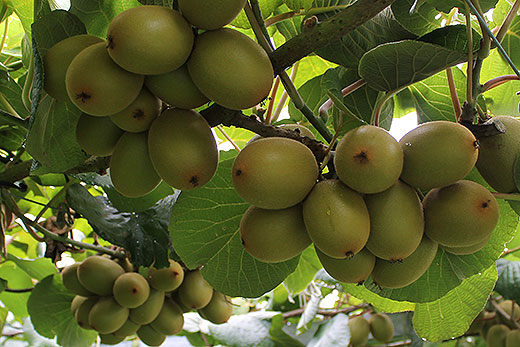The new gold kiwifruit variety G9 is ‘fatally flawed' and Zespri is doing the right thing in encouraging growers to stop growing it, says Tauranga grower Mike Smith.
The high yielding sweet fruit has a problem with ‘shrivelling' of its skin which is impacting on sales and Mike says while he's not happy about the decision, he supports Zespri because of the adverse impacts G9 could have on the brand.
The new gold variety G9 can develop a shrivelled skin which deters consumers from buying it.
Zespri Grower and Government Relations general manager Simon Limmer says the variety's future is uncertain because of market feedback from customers, wholesalers and retailers about Gold9 fruit deterioration.
'Zespri has made it clear to Gold9 growers the future of the variety is uncertain, due to inherent quality issues that have yet to be overcome.”
Simon says no decision has been made about the commercial future of Gold9.
'If a decision is made, growers will be entitled to the compensation outlined in their licence agreement with Zespri.”
G9 was released commercially four years ago and around 1.7 million trays currently grow on 140 ha.
The fruit can be grown in the Bay of Plenty without the use of the chemical Hi-Cane and it produces up to 24,575 trays per hectare of high tasting fruit.
One grower, who wants to remain anonymous, says he is extremely upset at Zespri's decision as in his opinion G9 is the best yielding and tasting gold fruit in the world.
'Someone somewhere will get its DNA and start producing it,” says the grower who has reluctantly grafted his G9 vines to the other gold variety G3.
He believes the shrivelling issue could be over-come by improved cool storage and handling facilities in the markets and that the fruit should be sold in niche markets, not alongside G3.
Mike Smith has also notch grafted his G9 vines to G3 and says next season will be the last harvest of the G9 fruit on his orchard.
'I think Zespri has tried to find answers to the shrivelling but hasn't been successful and unless a novel solution is found I think they have done the right thing.
'We can look in the rear vision mirror as to how G9 was released and why the shrivel problem didn't show up sooner, but that's not helpful.”
Simon says Zespri has offered a pathway forward for growers wanting to move out of Gold9 in the form of $10,000 per hectare of Gold9 removed and a Gold3 licence at no cost.
'Gold9 growers asked for a cost/benefit analysis of removing the Gold9 crop to be put to all gold growers for consideration. This offer was considered on top of what Zespri had offered to Gold9 growers.
'After extensive industry consultation, it was determined that there was not a sufficient level of gold grower support for the proposal to be carried.”
Simon says all new varieties carry some risk with them and the issues apparent with Gold9 have been made very clear to growers throughout the commercialisation process.
'Ultimately, growers make a decision about whether to invest in a new variety based on all the information put in front of them and on their own risk profile.”
All Gold9 fruit this year has been shipped and sold in the markets of Taiwan, Hong Kong, Korea and Australia. Gold9 was not sold in Japan in 2014 or 2013.



0 comments
Leave a Comment
You must be logged in to make a comment.